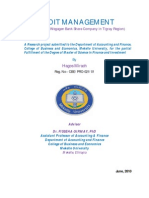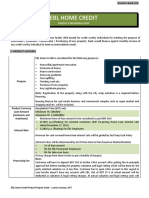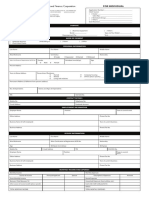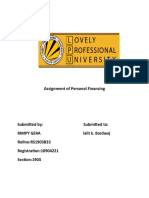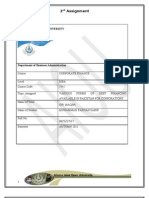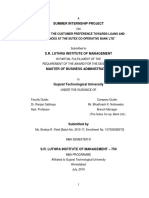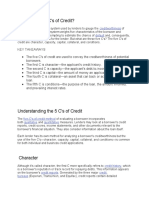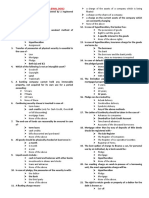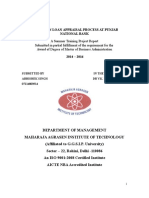0 ratings0% found this document useful (0 votes)
62 viewsCredit Boss
Credit Boss
Uploaded by
uttamdas79The document contains questions about various topics related to banking and finance including credit, types of security, intangible assets, provisions for loans, ratios, risk management, and credit approval processes. It asks multiple choice questions to test understanding of key concepts such as the limitation period for registered mortgages, definitions of pledge, hypothecation and floating charges, principles of sound lending, provisioning requirements, and risk management standards like Basel accords.
Copyright:
© All Rights Reserved
Available Formats
Download as DOCX, PDF, TXT or read online from Scribd
Credit Boss
Credit Boss
Uploaded by
uttamdas790 ratings0% found this document useful (0 votes)
62 views8 pagesThe document contains questions about various topics related to banking and finance including credit, types of security, intangible assets, provisions for loans, ratios, risk management, and credit approval processes. It asks multiple choice questions to test understanding of key concepts such as the limitation period for registered mortgages, definitions of pledge, hypothecation and floating charges, principles of sound lending, provisioning requirements, and risk management standards like Basel accords.
Original Title
credit boss
Copyright
© © All Rights Reserved
Available Formats
DOCX, PDF, TXT or read online from Scribd
Share this document
Did you find this document useful?
Is this content inappropriate?
The document contains questions about various topics related to banking and finance including credit, types of security, intangible assets, provisions for loans, ratios, risk management, and credit approval processes. It asks multiple choice questions to test understanding of key concepts such as the limitation period for registered mortgages, definitions of pledge, hypothecation and floating charges, principles of sound lending, provisioning requirements, and risk management standards like Basel accords.
Copyright:
© All Rights Reserved
Available Formats
Download as DOCX, PDF, TXT or read online from Scribd
Download as docx, pdf, or txt
0 ratings0% found this document useful (0 votes)
62 views8 pagesCredit Boss
Credit Boss
Uploaded by
uttamdas79The document contains questions about various topics related to banking and finance including credit, types of security, intangible assets, provisions for loans, ratios, risk management, and credit approval processes. It asks multiple choice questions to test understanding of key concepts such as the limitation period for registered mortgages, definitions of pledge, hypothecation and floating charges, principles of sound lending, provisioning requirements, and risk management standards like Basel accords.
Copyright:
© All Rights Reserved
Available Formats
Download as DOCX, PDF, TXT or read online from Scribd
Download as docx, pdf, or txt
You are on page 1of 8
Credit:
1. The limitation period of loan covered by a registered mortgage deed is -
A. Three years
B. Twelve years
C. Fifteen years
D. Twenty years
2. Which of the following is the weakest method of charging security?
A. A Pledge
B. Mortgage
C. Hypothecation
D. Assignment
3. Transfer of possession of physical security is essential in the case of -
A. Lien
B. Mortgage
C. Pledge
D. Both (a) and (C)
4. Which of the following is not an intangible asset?
A. Goodwill
B. Copyright
C. Land
D. Trademark
5. In case of hypothecation, the banker has -
A. The possession of goods
B. Right to sell the goods
C. A specific interest in the goods
D. None of the above rights
6. Pledge can be created by -
A. Actual delivery
B. Constructive delivery
C. Symbolic delivery
D. Any of the above methods.
7. The Letter of Continuity should be taken in the case of -
A. Advances to companies
B. Overdraft or Cash Credit Account
C. Time barred advances
D. Accounts of the deceased borrowers
8. A floating charge means –
A. a charge of the assets of a company which is being floated
B. a charge on the shares of a company
C. a charge on the current assets of the company which are constantly changing
D. None of the above
9. Principles of sound lending mean:
A. Safety, Security, Liquidity & Profitability of the fund
B. Security, Safety, Purchase, Spread & National Interest
C. Security, Safety, Purchase, Person & Capital
D. None of the above.
10. Bank Conduct Classification of Loan Activities as per BRPD circular
A. Monthly
B. Quarterly
C. Half yearly
D. Yearly
11. What is the percentage of provision kept for Doubtful Loans and Advances?
A. 5% of base for provision
B. 20% of base for provision
C. 50% of base for provision
D. 100% of base for provision
12. Calculate the eligible security of the Land and Building Mortgaged with the Bank.
A. 100% of market value
B. 75% of market value
C. Maximum 50% of market value
D. Maximum 50% of market forced sell value
13. Under what section of Negotiable Instrument Act we file criminal case?
A. Section 12
B. Section 112
C. Section 138
D. Section 133
14. Which one is not the irregularities in case of approving Loans and Advances
A. Over or Under Invoicing
B. Inadequate Security Stipulation
C. Undue Influence
D. Estimation of the cost of the project and means of finance
15. Which of the following is termed as earning asset
A. Deposit/Borrowing
B. Cash and Liquid Reserve
C. Investment
D. Capital
16. The pattern of the operating cycle follows __________.
A. Cash, procurement of RM, Work in process, Stock of FGs, Receivables, Cash
B. Procurement of RM, Work in process, Stock of FGs, Receivables, Cash
C. Cash, Work in process, procurement of RM, Receivables, Stock of FGs,
D. Cash, procurement of RM, Stock of FGs, Work in process, Receivables
17. At least how many years financial is required to prepare CRG?
A. 1 year
B. 2 years
C. 3 years
D. 5 years
18. The Primary Security of Overdraft (work order) is
A. Mortgage of Land & Building
B. Hypothecation of Stock
C. Personal Guarantee of the Proprietors/Directors
D. Assignment of Bill.
19. For collateral located outside Pourashava, the coverage should be:
A. 1.25 times of the proposed limit
B. 1.80 times of the proposed limit
C. 1.40 times of the proposed limit
D. 1.75 times of the proposed limit
20. What does ‘SPC’ stand for:
A. Sustainable Property Certificate
B. Security Perfection Certificate
C. Both (a) & (b)
D. None of the above.
21. What is the basic difference between OD (Gen) and CC (Hypo)?
A. Stock
B. Security
C. Capacity
D. None of the above
22. Current Ratio is
A. Quick assets / total liability
B. Current assets /current liability
C. External Equities / Internal equities
D. All of the above
23. The right of set – off is nothing but a ______.
A. right to sell.
B. right to retain.
C. right to combine
D. right to appropriate
24. Which type of Advance can be repayment without any specific date?
A. LTR.
B. LIM.
C. CC(Hypo).
D. OAP
25. CC (H) Drawing determined by?
A. Limit
B. Drawing Power
C. Limit or Drawing Power whichever is lower
D. Limit or Drawing Power whichever is higher
26. What is the rate of provision on Off-Balance Sheet exposures?
A. 0.25% on total exposure
B. 1.00% after deducting cash margin/eligible collateral
C. 1.00% on total exposure
D. 2.00% on total exposure
27. Liquidity Ratio indicates to meet future-
A. Short term financial obligation;
B. Long term financial obligation;
C. Both Short and Long term financial obligation;
D. None of the above.
28. Asset Utilization (Activity) Ratio indicates to meet-
A. Short term financial obligation;
B. Long term financial obligation;
C. Working Capital obligation;
D. None of the above.
29. Debt Service Coverage Ratio indicates to meet-
A. Interest Servicing obligation;
B. Principal Servicing obligation;
C. Both Interest & Principal Servicing obligation;
D. None of the above.
30. Interest Coverage Ratio indicates to meet-
A. Interest Servicing obligation;
B. Principal Servicing obligation;
C. Both Interest & Principal Servicing obligation;
D. None of the above.
31. Which one of the following is true about loan write-off?
A. 100 percent provision is required before write-off
B. It is done for cleaning balance sheet
C. Loan amounting taka upto 50,000 can be written-off without filing suit
D. All of these
32. Which of the following is true for base for provision calculation?
A. Outstanding loan - balance of interest suspense
B. Outstanding loan - balance of interest suspense - value of eligible securities
C. Outstanding loan - value of eligible securities
D. None of these
33. Economic aspect of a project deals with-
A. Private cost and benefit
B. Central bank's cost and benefit
C. Social cost and benefit
D. Direct foreign investors' cost and benefit
34. Which of the following is known as horizontal analysis?
A. Common size analysis
B. Scenario Analysis
C. Ratio analysis
D. Trend Analysis
35. Line of credit is term frequently used in business terminology .it refers to-
A. The use of credit facility in the operational activities
B. The maximum amount of loan an organization can avail
C. The basis on which credit can be utilized
D. The limits set for acquiring credit
36. Ratios are mathematical indicators which are calculated by comparing two values, financial
ratios help in-
A. Estimating the company’s gross profit
B. Understanding the financial workings of the company
C. Analysing the financial statements
D. Understanding the internal working structure in the company.
37. Which of the following is the probability that market interest rates will change and cause it to
have lower profits or a decrease in the value of its equity?
A. Credit risk
B. Market risk
C. Strategic risk
D. Interest rate risk
38 Which of the following is used as the highest layers in credit approval process?
A. Source of cash flows
B. Type of borrower
C. Value and type of collateral
D. Amount and type of claim
39. Which of the following is an important tool in monitoring and controlling credit risk?
A. Holistic rating
B. Interval rating
C. Internal risk rating
D. Analytical rating
40. Which of the following are to be followed by commercial banks to risk management?
A. Basel I norms
B. Basel II norms
C. Basel III norms
D. Solvency II norms
41. What is factoring?
A. An easy way of rising capital from a factoring company by small business
B. Selling of account receivables on a contract basis for cash payment to factor before it is
due.
C. An arrangement for raising short term money against prepaid expenses
D. A method of discounting a loan term bills.
42. Which one of the following is the ratio of the loan principal to the appraised value?
A. Combined loan to value (CL IV) ratio
B. Loan to value ratio
C. Mortgage loan
D. Statutory liquidity ratio
43. ALM approach emphasize more on –
A. Asset management
B. Liquidity management
C. Liability management
D. Coordinated approach to assets and liabilities
44. As regard ratings and aggregate quantitative score in ICRR, which of the following is not true?
A. Aggregate score of 80 or greater is excellent.
B. Aggregate score of 70 or greater but less than 80 is good.
C. Aggregate score of 60 or greater but less than 75 is marginal.
D. Aggregate score less than 60 is unacceptable.
45. IRR is the discount rate is which –
A. NPV = 0
B. NPV ≠ 0
C. NPV ≤ 0
D. NPV ≥ 0
46. Restrictions on the respite of loans have been imposed under which section of the Bank
Company Act, 1991 (as amended in 2013)
A. Section 14A
B. Section 27
C. Section 26A
D. Section 28
47. Quantitative Credit controls do not include-
A. Bank Rate
B. CRR
C. BB Directives
D. Open market operations
48. The primary objectives of Nationalizations of banks was-
A. Improving credit facilities
B. Improving security of deposits
C. Financing in Industries
D. Consolidating the economy
49. Pricing of the Loan is set by?
A. CRMD
B. Corporate Banking Division
C. ALCO
D. General Banking Division
50. Maximum what % of current remaining time to maturity of a term loan may be extended?
A. 35 %
B. 25 %
C. 10 %
D. None
1 2 3 4 5 6 7 8 9 10
B C D C C B B C A B
11 12 13 14 15 16 17 18 19 20
C C C D C A C D D B
21 22 23 24 25 26 27 28 29 30
A B C C C C A C C A
31 32 33 34 35 36 37 38 39 40
D B C D B C D B C B
41 42 43 44 45 46 47 48 49 50
B B D C A D C A C B
You might also like
- Buying The Farm I by Bill AckmanDocument52 pagesBuying The Farm I by Bill Ackmanscottleey100% (2)
- Corporate BankingDocument12 pagesCorporate Bankingbpsc08No ratings yet
- PA Real Estate Exam Study SheetDocument42 pagesPA Real Estate Exam Study Sheetnic jNo ratings yet
- A Study On Home Loans (Rajni) (Mba-3rd Sem - Finance) (Col-Rdias) DelhiDocument133 pagesA Study On Home Loans (Rajni) (Mba-3rd Sem - Finance) (Col-Rdias) Delhi*8984% (231)
- Strategies of Recovering Default LoansDocument7 pagesStrategies of Recovering Default LoansMariam Adams100% (1)
- RBI Act 1934 NDocument42 pagesRBI Act 1934 NRohit SinghNo ratings yet
- Consumer CreditDocument12 pagesConsumer CreditDrpranav Saraswat100% (3)
- Credit ManagementDocument34 pagesCredit Managementromanahmed16No ratings yet
- Question Title: 1. How Many Credit Cards Do You Have?Document4 pagesQuestion Title: 1. How Many Credit Cards Do You Have?Mahesh KunaNo ratings yet
- Credit ManagementDocument115 pagesCredit ManagementKhalid Mishczsuski LimuNo ratings yet
- United Leasing Company LimitedDocument46 pagesUnited Leasing Company LimitedTanjina RahmanNo ratings yet
- A Study On IDLC Finance LimitedDocument33 pagesA Study On IDLC Finance LimitedKelly McmillanNo ratings yet
- Ebl Home Credit: Product Program GuideDocument8 pagesEbl Home Credit: Product Program GuideAl Amin GaziNo ratings yet
- Overview of Credit AppraisalDocument14 pagesOverview of Credit AppraisalAsim MahatoNo ratings yet
- Credit Risk Management of United Commercial BDocument45 pagesCredit Risk Management of United Commercial Bএকজন নিশাচরNo ratings yet
- Vidya Guru Banking NotesDocument20 pagesVidya Guru Banking NotesGaurav ShahNo ratings yet
- Credit Application Forms - Individual and CorporationDocument4 pagesCredit Application Forms - Individual and Corporationjjjandm lpgtradingNo ratings yet
- Credit Education ProgramDocument11 pagesCredit Education ProgramBlack HeartNo ratings yet
- Assignment of Personal FinancingDocument11 pagesAssignment of Personal FinancingRimpy GeraNo ratings yet
- Commercial BankingDocument4 pagesCommercial Bankingsn nNo ratings yet
- Chapter 7. Consumer CreditDocument27 pagesChapter 7. Consumer CreditshitalNo ratings yet
- U.S. Information Return Trust Accumulation of Charitable AmountsDocument4 pagesU.S. Information Return Trust Accumulation of Charitable AmountsIRSNo ratings yet
- Presented To: Vibha Jain Presented By: Nishu Chopra Semester 03 (2009-11) SrimDocument14 pagesPresented To: Vibha Jain Presented By: Nishu Chopra Semester 03 (2009-11) Srimbansi2kkNo ratings yet
- E-Book Credit RatingsDocument5 pagesE-Book Credit Ratingsrosslee@iafrica.comNo ratings yet
- Credit RatingDocument28 pagesCredit Ratingak5775No ratings yet
- 4.1.s.methods of PaymentDocument23 pages4.1.s.methods of PaymentK59 Dao Nam PhuongNo ratings yet
- Extra Credit ExcerptDocument14 pagesExtra Credit ExcerptMacmillan KidsNo ratings yet
- 2 Assignment: Department of Business AdministrationDocument14 pages2 Assignment: Department of Business AdministrationFarhan KhanNo ratings yet
- Receivable & Payable Management PDFDocument7 pagesReceivable & Payable Management PDFa0mittal7No ratings yet
- Loans and Advances 2016Document128 pagesLoans and Advances 2016Anonymous kyvLgSREMNo ratings yet
- Banking Code BCSBI PDFDocument9 pagesBanking Code BCSBI PDFVijay RoheriaNo ratings yet
- Acf 465 International Trade Finance 2016Document365 pagesAcf 465 International Trade Finance 2016John OmarNo ratings yet
- Loan Recovery Policy - StatebankoftravancoreDocument2 pagesLoan Recovery Policy - StatebankoftravancoreBhagyanath Menon100% (1)
- Loan OfficerDocument4 pagesLoan OfficerAnna-kay Clarke100% (1)
- Commercial Banking in IndiaDocument32 pagesCommercial Banking in IndiaShaifali ChauhanNo ratings yet
- Corporate Banking - FaisalDocument27 pagesCorporate Banking - FaisalVijender SinghNo ratings yet
- Course Background: Prof. Abhijit Roy Mobile: 09810817716Document3 pagesCourse Background: Prof. Abhijit Roy Mobile: 09810817716Aayush RastogiNo ratings yet
- Unit 3 MoneyDocument3 pagesUnit 3 MoneyAlexanderVillacrés0% (1)
- Project: D.Pradeep KumarDocument24 pagesProject: D.Pradeep KumarHarshit ManikNo ratings yet
- Deposit OperationsDocument17 pagesDeposit OperationsArmela HasmucaNo ratings yet
- BAnking Terms and InterviewsDocument25 pagesBAnking Terms and InterviewsassadbilalNo ratings yet
- 1 (Rev) Corporate GovernanceDocument16 pages1 (Rev) Corporate GovernanceSourav SenNo ratings yet
- UCC - Certificate-In Computer ITDocument2 pagesUCC - Certificate-In Computer ITMutabirwaNo ratings yet
- Banking Module-1Document6 pagesBanking Module-1sagar bevoorNo ratings yet
- HSBC4-Credit Card TrapDocument13 pagesHSBC4-Credit Card TrapHBSIE7No ratings yet
- List of Accounting StandardsDocument5 pagesList of Accounting StandardsPraneeth SaiNo ratings yet
- What Are The 5 C's of Credit?: Key TakeawaysDocument3 pagesWhat Are The 5 C's of Credit?: Key TakeawaysUSMANNo ratings yet
- Legal and Ethical Issues With Payday LoansDocument13 pagesLegal and Ethical Issues With Payday Loansmichael4545No ratings yet
- Bank Loan DefaultDocument7 pagesBank Loan DefaultGolam Samdanee TaneemNo ratings yet
- Credit Report PresentationDocument26 pagesCredit Report Presentationbjenkins8778100% (2)
- Andrew Ladick v. Gerald J. Van Gemert Law Offices of Gerald J. Van Gemert, A Professional Corporation, 146 F.3d 1205, 10th Cir. (1998)Document4 pagesAndrew Ladick v. Gerald J. Van Gemert Law Offices of Gerald J. Van Gemert, A Professional Corporation, 146 F.3d 1205, 10th Cir. (1998)Scribd Government DocsNo ratings yet
- Mobilization of FundsDocument2 pagesMobilization of FundsSidra SidNo ratings yet
- Steps of Loan ProcessDocument16 pagesSteps of Loan ProcessShraddha TiwariNo ratings yet
- Fundamentals of Agent BankingDocument22 pagesFundamentals of Agent Bankingbenjamin ghulam100% (1)
- Overview of Lending Activity: by Dr. Ashok K. DubeyDocument19 pagesOverview of Lending Activity: by Dr. Ashok K. DubeySmitha R AcharyaNo ratings yet
- General Banking KnowledgeDocument696 pagesGeneral Banking Knowledgerajeev naikNo ratings yet
- FBN Holdings PLC 2020 Annual Report and AccountDocument358 pagesFBN Holdings PLC 2020 Annual Report and AccountJoseph OgarNo ratings yet
- FINANCE - CreditDocument9 pagesFINANCE - CreditHoney Gubalane100% (1)
- Questions - Incoterms 2010 - WA - PDFDocument5 pagesQuestions - Incoterms 2010 - WA - PDFuttamdas79No ratings yet
- Next Gen BankingDocument5 pagesNext Gen Bankinguttamdas79No ratings yet
- Credit Questions Summarized (Final Dose)Document40 pagesCredit Questions Summarized (Final Dose)uttamdas79100% (1)
- Trade Finance Question BankDocument10 pagesTrade Finance Question Bankuttamdas79No ratings yet
- Foreign Trade (FEX)Document11 pagesForeign Trade (FEX)uttamdas79No ratings yet
- Credit MaretialsDocument21 pagesCredit Maretialsuttamdas79No ratings yet
- GB MaterialsDocument21 pagesGB Materialsuttamdas79100% (1)
- RMG DivisionDocument5 pagesRMG Divisionuttamdas79No ratings yet
- Assignment 2Document10 pagesAssignment 2patrick wafulaNo ratings yet
- Mortgage BankDocument85 pagesMortgage BankAashika ShahNo ratings yet
- Crowd Real Estate Site TrackingDocument56 pagesCrowd Real Estate Site TrackingahgonzalezpNo ratings yet
- Abu Dhabi Finance-GlossaryDocument18 pagesAbu Dhabi Finance-GlossaryManjul TakleNo ratings yet
- LFC Sector Update 13Document16 pagesLFC Sector Update 13Randora LkNo ratings yet
- ASRI Annual Report 2016Document244 pagesASRI Annual Report 2016Ahmad JailaniNo ratings yet
- Prioritisation of Key Attributes Influencing The Decision To Purchase A Residential Property in Malaysia - An Analytic Hierarchy Process (AHP) ApproachDocument24 pagesPrioritisation of Key Attributes Influencing The Decision To Purchase A Residential Property in Malaysia - An Analytic Hierarchy Process (AHP) ApproachElvin MichaelsNo ratings yet
- 11.financing For Low Income Housing - Magnitude and Economics - Monitor GroupDocument24 pages11.financing For Low Income Housing - Magnitude and Economics - Monitor Groupalex.nogueira396No ratings yet
- Housing Bond Basics: A Developer's PerspectiveDocument37 pagesHousing Bond Basics: A Developer's PerspectiveSrikanth VukkaNo ratings yet
- Q2 2023 - Bridging Lending Guide - UWDocument13 pagesQ2 2023 - Bridging Lending Guide - UWgoldenquestland investmentsNo ratings yet
- Loan Appraisal Process of PNBDocument71 pagesLoan Appraisal Process of PNBNAVPREET SINGHNo ratings yet
- Unit 5 Additional Questions Lending StudentsDocument2 pagesUnit 5 Additional Questions Lending Studentsrojay burtonNo ratings yet
- Can Fin Homes - IC Oct, 2017Document11 pagesCan Fin Homes - IC Oct, 2017milandeepNo ratings yet
- House Prices and Monetary Policy Dec 2020Document11 pagesHouse Prices and Monetary Policy Dec 2020Thomas CoughlanNo ratings yet
- 2021 The Peebles Corporation V The Peebles Corporation EXHIBIT S 61Document10 pages2021 The Peebles Corporation V The Peebles Corporation EXHIBIT S 61Don Peebles Financial DocumentsNo ratings yet
- Commercial Real Estate LendingDocument133 pagesCommercial Real Estate LendingMarcelo Pozo100% (1)
- 2bed Apartment GlasgowDocument9 pages2bed Apartment GlasgowMark I'AnsonNo ratings yet
- Flexible Mortgage Solutions For Extraordinary People: Multi-FamilyDocument8 pagesFlexible Mortgage Solutions For Extraordinary People: Multi-FamilyDarnellNo ratings yet
- Understanding The 5 Cs of CreditDocument15 pagesUnderstanding The 5 Cs of CreditVic Angelo TuquibNo ratings yet
- Buy It Fix It Sell It ProfitDocument313 pagesBuy It Fix It Sell It ProfitJohn100% (1)
- House Prices and The Distribution of Wealth AroundDocument38 pagesHouse Prices and The Distribution of Wealth AroundSitoYscNo ratings yet
- Tutorial 1 AnswerDocument6 pagesTutorial 1 AnswerPuteri XjadiNo ratings yet
- Financial Planning 2 Edition: TestbankDocument20 pagesFinancial Planning 2 Edition: Testbank李佳南No ratings yet
- Mortgage Process As A ServiceDocument21 pagesMortgage Process As A ServiceCognizantNo ratings yet
- Home Equity and Mortgage Loans 4.12.24Document1 pageHome Equity and Mortgage Loans 4.12.24melissagold11416No ratings yet
- NMLSbookDocument386 pagesNMLSbookejsimonsenNo ratings yet
- Refinance Analysis v1.01Document1 pageRefinance Analysis v1.01AlexNo ratings yet









